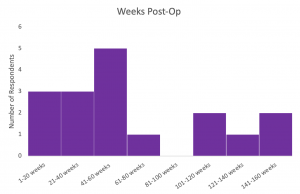Local/Stoma Infection
Incidence and Timing
The search term “infection” was used to find postings related to local/stoma infections.

The duration of time since the osseointegration surgery was reported by 17 of the 24 respondents, with a median time of 52 weeks (1 years). The range in reports was from 3 weeks to 156 weeks.

Symptoms
Respondents described their local/stoma infections as an infection around the stoma, skin infections, surface infections, tissue infections, and infections of the stoma. Respondents also described their stoma/local infection as cellulitis, recurrent skin infections, and MRSA. Some of the symptoms that respondents reported often included pain, discharge, and discomfort related the infection. There were also reports of an odour change to the stoma, or an odour change to the stoma’s discharge.
What People Have Tried
The use of antibiotics seemed to be the most common intervention. Of these, oral antibiotics [1] were the most common type, with other types of antibiotic cream or antifungal cream also mentioned. Some of the cream types that were reported included Resolve Plus cream and Solosite cream. Some of the individuals who reported infection also advised that they used other types of treatments as well, including washing their stoma with substances like oregano oil or colloidal silver. Several respondents reported being hospitalized for a number of reasons including the need for intravenous antibiotics or debridement to remove infected tissue. There were recommendations for ensuring proper cleaning of the stoma, with one respondent saying they wash their stoma with soap and water. Another respondent reported that they would apply ice to their stoma and elevate their leg. One respondent reported that after working in their garden they experienced several of the symptoms listed above and when they went to their health care provider, it was found that there were maggots in their stoma [2].
Fact Checkers
[1] In order for antibiotics to be effective, a whole course of treatment of antibiotics must be completed (Holman, 2016). Antibiotic resistance can develop if the whole prescribed dose of antibiotics is not taken. Antibiotic resistance describes the way bacteria evolve mechanisms to protect themselves from the effects of antibiotics. This means it will take greater and stronger antibiotics to get rid of the infection later on. Antibiotic resistant infections cause millions of deaths annually, which is why it is so important to ensure that antibiotics are taken properly.
[2] Maggot infestation of an OI stoma occurs when flies lay their eggs in the stoma, the eggs turn into larvae that eat dead tissue (James et. al., 2018). It has been suggested that maggot infestation can cause greater psychological damage than physical due to peoples’ aversion to maggots. Despite the ‘gross’ factor, maggots are not all bad news. In fact, maggots are used to treat wounds, in what is called larvae therapy.
Help keep this resource alive.
Please click this Qualtrics link to complete a survey to help us grow the information and keep this resource up to date.
